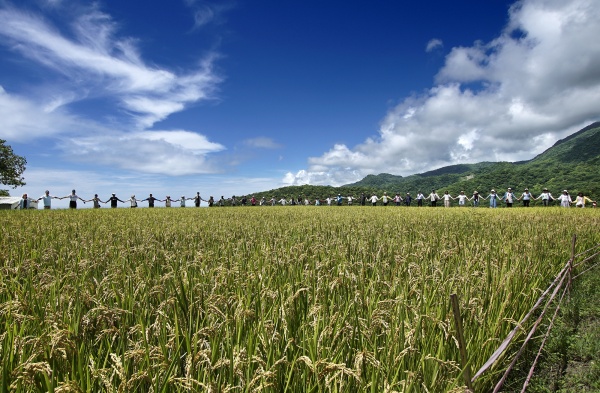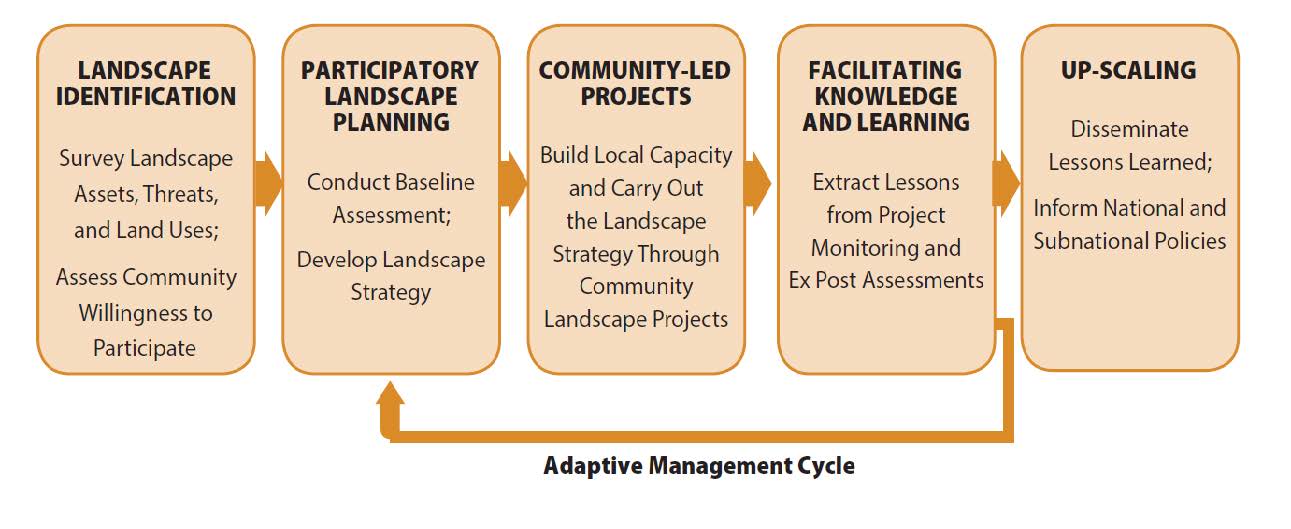ACTIVITIES

TOPACTIVITIESIPSI Collaborative ActivitiesCOMDEKS Phase 4: The Community Development and Knowledge Management for the Satoyama Initiative Prog...
COMDEKS Phase 4: The Community Development and Knowledge Management for the Satoyama Initiative Programme
Lead organization: United Nations Development Programme (UNDP)
Other participating organizations: Ministry of the Environment Japan (MOEJ); Secretariat of the Convention on Biological Diversity (SCBD); United Nations University Institute for the Advanced Study of Sustainability (UNU-IAS); Keidanren Nature Conservation Fund (KNCF); and Keidanren Nature Conservation Council (KNCC)
Background:
The Community Development and Knowledge Management for the Satoyama Initiative Programme (COMDEKS) was launched in 2011 as a flagship programme of the Satoyama Initiative- a global effort to promote sustainable use of natural resources in landscapes and seascapes with local communities. These working landscapes and seascapes, known as socio-ecological production landscapes and seascapes (SEPLS), include many uses, from farming and fishing to forestry.
Since 2011, Phase 1 to Phase 3 of the COMDEKS Initiative were funded by the Japan Biodiversity Fund (JBF) at the Secretariat of the Convention on Biological Diversity (CBD) through a $10.5 million combined contribution. The programme was implemented by United Nations Development Programme (UNDP) through the GEF Small Grants Programme (SGP), in partnership with the Ministry of the Environment of Japan (MOEJ), the CBD Secretariat (SCBD), and the United Nations University Institute for the Advanced Study of Sustainability (UNU-IAS). All COMDEKS activities at the country level were delivered through the network of country programmes under the SGP, implemented by UNDP. Phases 1 to 3 have been implemented in a variety of landscapes and seascapes in 20 participating countries around the world through over 400 related projects.
The COMDEKS programme provides small-scale finance- delivered through the GEF Small Grants Programme (SGP)- directly to local communities, Indigenous Peoples and civil society to implement locally led projects that enhance livelihoods and well-being, conserve biodiversity, address climate change, and support local cultures and traditional practices. In this way, COMDEKS activities not only contribute to the ecological resilience of SEPLS, but also strengthen the social and economic resilience of communities within these areas. By enhancing governance and participatory decision-making processes in local communities, COMDEKS offers a critical pathway for humans to effectively manage natural resources and live in greater harmony with nature. The programme also collects and disseminates knowledge and experiences from successful local initiatives to facilitate broader adoption by other communities around the world. To achieve its ends, COMDEKS utilizes a framework built around a cycle of adaptive management where communities assess their landscape/seascape; identify desirable ecological, social, and economic outcomes as building blocks of resilience; plan activities to boost ecosystem productivity and sustainability, improve the organizational capacities of communities; execute projects and measure results; and adapt their planning and management practices to reflect lessons learned. This process is illustrated below:

Background:
At the Fifteenth meeting of the Conference of the Parties to the Convention on Biological Diversity (COP15) in Montreal, Canada, the Ministry of the Environment Japan (MOEJ), Keidanren Committee on Nature Conservation (KCNC), United Nations Development Programme (UNDP), and other partners announced the launch of COMDEKS Phase 4. This phase aims to further expand and ensure sustainability and sound biodiversity management, governance and sustainable livelihood activities with local communities in SEPLS.
Phase 4 Goal: to further expand and ensure sustainability and sound biodiversity management, governance and sustainable livelihood activities with local communities in socio-ecological production landscapes and seascapes.
Total funding: 1 billion Japanese Yen
Timeframe: 2022 to 2027
Participating countries (15): Nepal, Vietnam, Bhutan, Cambodia, Samoa, Kyrgyzstan, Morocco, Turkey, Jamaica, Peru, Costa Rica, Cameroon, Ghana, Tanzania, Uganda.
Implementation sites: SEPLS in each participating country will be selected as project sites in collaboration with local communities, civil society, the SGP Country Programmes and other partners.
Alignment/contribution to the Sustainable Development Goals: 1, 2, 3, 10, 12, 13, 14, 15, 16, 17
Key partners: MOEJ, KNCF/KNCC, SCBD, UNU-IAS, GEF SGP UNDP

Phase 4 aims to provide valuable contributions to the implementation of the Kunming-Montreal Global Biodiversity Framework, including in relation to target 3 on the “30 by 30” goals to expand conservation of biodiversity in 30 percent of the landscapes and seascapes globally, target 2 on restoration of at least 30 percent of degraded ecosystems, and target 10 on sustainable use of biodiversity in agriculture, aquaculture, fisheries and forestry. The programme will also contribute to sustainable use of biodiversity resources at the socio-ecological production landscapes and seascapes in diverse countries under their National Biodiversity Strategies and Action Plans (NBSAPs). Lessons learned from the implementation of Phase 4 will be disseminated through the global network of 127 SGP Country Programmes, the International Partnership for the Satoyama Initiative (IPSI), and other partners worldwide for further upscaling and replication.
COMDEKS Phase 4 also aligns to the recently adopted IPSI Strategy and Plan of Action for 2023-2030, in particular its objectives on knowledge management and uptake, capacity development, area-based conservation measures and OECMs, ecosystem restoration and value chain development.
| Project Components | Expected Concrete Outputs | Expected Outcomes |
| Component 1: Sustainable landscape and seascape management through grant-making to civil society and community-based organizations, |
1.1. Landscape/seascape strategies developed for each participating country to guide the implementation of community-based projects to achieve socio-ecological production landscape and seascape resilience. 1.2. Portfolio of 5-10 community-led projects addressing improved resilience of socio-ecological production landscapes and seascapes implemented in each of the 15 participating countries, including policy development (OECMs, protected areas network, production sector policy including phase out of negative impact on SEPLS, etc.) and implementation and testing of resilience indicators for SEPLS and community level sustainable financing mechanism. |
1.1. National and local level organizations and institutions have enhanced the understanding, strategies, tools, skills and technical capacities required to conserve and restore socio-ecological production landscape and seascape in participating countries. |
| Component 2: Knowledge Management for capacity development, replication, and up-scaling |
2.1 Learning and knowledge sharing among participating countries and others: combining workshops, webinars and social media are launched in order to enhance understanding and raise awareness of the importance of SEPLS for the benefit of biodiversity and human wellbeing, in coordination with IPSI. 2.2: Best practices and lessons learned exchanged among countries and IPSI partners through case studies development for replication and upscaling, including the use of resilience Indicators. 2.3 Policy makers engaged in the landscape/seascape process at all levels: Lessons from community-based landscape and seascape management related activities compiled and disseminated to governmental officials and policy makers at the local, national and global level for coherent policy development, including approaches on SEPLS are incorporated in NBSAPs, and phase out of negative subsidies to biodiversity conservation in relevant countries. |
2.1 Practitioners at the global, national and local levels and local stakeholders’ access and exchange knowledge, experience, best practices and lessons from socio-ecological production landscapes and seascapes, to incorporate lessons learned into planning tools and enable replication and upscaling of best practices around the word. |
Background:
The implementation of COMDEKS Phase 4 will be undertaken through UNDP and delivered through the GEF Small Grants Programme. UNDP will operate under the grant agreements that are concluded separately with the MOEJ and KNCF.
SGP will provide financing and technical assistance to civil society and community-based organizations in selected developing countries to enhance the recognition of socio-ecological production landscapes and seascapes approach. This includes making use of the existing organizational structure including the SGP Central Programme Management Team at the global level as well as National Steering Committees (NSC) and the SGP National Coordinator (NC) at the country level. Oversight for Phase 4 of COMDEKS project will be provided by the UNDP Nature Hub.
Project Board: At the global level, implementation of the project will be carried out under the general guidance of a Project Board. The Project Board will be responsible for approving key management decisions of the project and will play a critical role in assuring the technical quality, financial transparency and overall development impact of the project. The Project Board will be composed of designated representatives from UNDP, MOEJ, KNCF/KCNC, SCBD, UNU-IAS, while having Small Grants Programme as the secretariat. Inception meetings and periodic webinars will be organized to apprise the Project Board of progress on implementation. Other relevant organizations may be invited to participate in project board meetings to support and facilitate knowledge sharing and learning on the Satoyama Initiative among IPSI partners as relevant.
UNDP: Through the Small Grants Programme, will implement the project including providing quality assurance and oversight services, ensuring that the objectives and components of the project are delivered, and resources are allocated and disbursed in an efficient and effective manner. Implementation will be aligned to SGP’s Operational Guidelines and Procedures. UNDP will also provide information and reports to the donors as necessary to secure the financial contributions for the sustainable operation of the project.
Ministry of the Environment Japan (MOEJ): As a donor, the MOEJ will ensure the provision of necessary funds for the operation of the fourth phase of COMDEKS. It will also provide liaison and coordination functions with relevant Japanese government agencies, bilateral meetings with other countries, and dissemination of the results of COMDEKS as a representative of the Japanese government at relevant international conferences and events such as CBD meetings.
Keidanren Nature Conservation Fund (KNCF) /Keidanren Nature Conservation Council (KNCC): KNCF has a grant policy to support NGO activities that contribute to the targets of the Kunming-Montreal Biodiversity Framework adopted at COP15. In line with its policy, KNCF is a donor to COMDEKS Phase 4, and is providing funding of 300 million yen over a five-year period from 2023 to 2027.
KNCC is an association of 134 Japanese companies committed to biodiversity conservation, and supports activities of NGOs in various countries through the KNCF, providing information to member companies, and making policy recommendations to government officials, etc. KNCC, in cooperation with the Ministry of the Environment and UNDP, is working to raise awareness in Japan about COMDEKS, and will be organizing events to further disseminate Japanese knowledge and experience on the sustainable use of natural capital.
Secretariat of the Convention on Biological Diversity (SCBD): SCBD will share information and provide advice on the implementation of the project and opportunities for disseminating the outcomes of COMDEKS to ensure that COMDEKS can effectively contribute to the implementation of the Kunming-Montreal Global Biodiversity Framework.
United Nations University Institute for the Advanced Study of Sustainability (UNU-IAS): UNU-IAS will provide technical inputs and make available resources such as the revised SEPLS Resilience Indicators, Guidance on integrating landscape approaches into NBSAPs and related to support the successful implementation of the project. It will also work closely with the different partners in the development and dissemination of knowledge and outreach products from the project activities.
Monitoring and Evaluation
The project will be monitored through the following monitoring and evaluation activities, in accordance with established UNDP procedures. A set of indicators will be developed to effectively monitor project progress and results. There will be a) annual progress and financial reports at agreed timing as per the grant agreement with each donor; and b) final substantive report. Through these reports, the following information of each project of COMDEKS Phase 4 will be communicated; a) tangible outcomes, b) Sustainability and future plan after COMDEKS Phase 4, and c) Co-finance.
Monitoring and evaluation will also be aligned to SGP’s global programme monitoring and evaluation guidelines.


